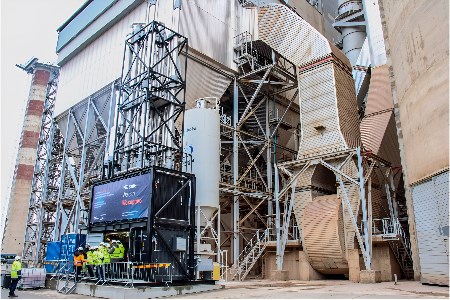Harnessing Heat For Carbon Control
Published by Alfie Lloyd-Perks,
Assistant Editor
World Cement,
Cato Christiansen, Capsol Technologies, explores how innovative CO2 capture solutions are transforming cement production through energy-efficient, fully electric post-combustion processes and waste heat integration.

More and more cement producers have initiated their carbon capture strategy by investigating available technologies and technology pathways. The most common technologies being evaluated by the industry for capturing CO2 are various oxy-combustion technologies, CO2-fractionation, and solvent-based post-combustion solutions. Each technology possesses distinct strengths and weaknesses, and there does not seem to be any universally applicable solution. Solvent-based post-combustion technologies are often considered the most mature and most realistic choice for retrofitting CCUS to a cement plant today. Oxy-combustion technologies are considered less mature and can be challenging to retrofit. CO2-fractionation would be easily retrofittable but less mature than solvent technologies.
Challenges using most solvent-based capture technologies
Although certain post-combustion absorption technologies are commercially available and readily retrofittable (mainly amine-based), their implementation in the cement industry presents several challenges. For instance, the presence of relatively high amounts of contaminants in cement flue gas can lead to increased solvent degradation, resulting in substantial solvent consumption and the potential release of harmful degradation products into the atmosphere. This, in turn, can complicate the emission permitting process. Additionally, these technologies are typically heat-driven and require substantial heat inputs for solvent regeneration.
Carbon capture technologies, such as amines or chilled ammonia, were originally developed to be integrated before a thermal power plant stack to capture CO2 after the combustion of fossil fuels, hence the designation of ‘post-combustion’ capture technology. The heat extraction to drive the capture process from the thermal power plant will result in a parasitic loss for the power plant, but there is more than enough heat available.
In contrast, the situation is typically quite different for a cement plant. While the cement plant may possess waste heat that the capture plant can utilise, the quantity of waste heat is insufficient to power the capture plant solely. Consequently, the installation of an externally fuelled or electric steam supply becomes necessary to enable the operation of the capture plant. This might be an option for some cement plants, but for others, this rules out the use of such CO2 capture solutions.
Potassium carbonate as a post-combustion solution
Potassium carbonate is an alternative to amines and has been used commercially to capture CO2 from different gas mixtures in various industries for several decades. This process is often referred to as the hot potassium carbonate process (HPC). Industries where HPC systems are utilised include ammonia and hydrogen plants, natural gas, ethylene oxide recycle gas, vinyl acetate monomer recycle gas, and methanol synthesis plants.
Due to its inorganic chemistry and resistance to thermal and oxygen degradation, potassium carbonate is also well suited for industrial flue gas applications. In addition, the potassium carbonate solvent has a very low vapour pressure, so neither the solvent nor any degradation products will end up in the treated flue gas emitted to the atmosphere or in the CO2 product. This significantly eases the emission permitting process.
One perceived disadvantage of the HPC process is that it is a slow solvent compared to amine-based solvents used for post-combustion CO2 capture. Without adding new and significantly improved promoters, there is a need to compress the flue gas to achieve the required CO2 partial pressure to effectively capture CO2 from flue gases. Flue gas compression has generally been seen as having too high an energy penalty. Most efforts to make the HPC process work for industrial flue gases have focused on modifying the chemistry by adding new promoters/catalysers to make the process energy efficient. So far, this effort has not been overly successful.
A different approach to post-combustion HPC
Capsol Technologies has attacked the perceived disadvantage of HPC being a slow solvent in a different way. Solvent chemistry is important, but what if the solution to the challenge of making HPC work well in flue gas applications lies not only in manipulating solvent chemistry? Can the focus instead be on adapting the process design and/or manipulating the flue gas?
Instead of viewing flue gas compression as an energy-intensive problem, Capsol Technologies has recognised it as a potential opportunity. Rather than considering the HPC solvent solely as a chemical absorbent, Capsol Technologies also treats it as a working fluid in a thermodynamic cycle.
Enjoyed what you've read so far? Read the full article and the rest of the July issue of World Cement by registering today for free!
Read the article online at: https://www.worldcement.com/special-reports/21072025/harnessing-heat-for-carbon-control/
You might also like
The World Cement Podcast - The changing face of cement in Europe
In this special joint episode of the World Cement Podcast and Cementing Europe’s Future, Senior Editor David Bizley is once again joined by Koen Coppelholle, CEO of Cement Europe (formerly CEMBUREAU). The two discuss the reasons behind the rebrand, a new action plan for cement, and the future of the industry.
Tune in to the World Cement Podcast on your favourite podcast app today.

